

Article 1 Reinders and Cho. Creative Classrooms Lab project- Pan-European policy experimentations with tablets. Mobile learning. Learning activities and video case studies. Www.tirfonline.org/wp-content/uploads/2013/11/TIRF_MALL_Papers_Traxler.pdf. Nexus 4 (16GB) - Google Play. Swansea tablet computer project boosts pupils' reading. A new way of using tablet computers in schools could change how children are taught in Wales, says Education Minister Leighton Andrews.

It follows a project using the computers developed at Casllwchwr Primary in Swansea. When tested at another primary, Year Six children saw average reading ages leap from nine to 13. Mr Andrews wants the teaching profession to see how the tailored learning programme could help others. "We've had the input from Casllwchwr and other technologically advanced schools, both primary and secondary in Wales looking at digital classroom teaching," he said. "We've rolled that experience out," said the minister. But he said that the real issue now was for education authorities, education directors, and council leaders to grasp what had been done in Swansea. "They need to see it at first hand had to understand the really transformational potential of what Casllwchwr has achieved," he insisted.
"It meant that they quickly became confident. Internet Catalogue. Award Winning Leadership in Mobile Teaching and Learning! Learning Services have been awarded a Mobile Innovation Award as part of the 2013 Blackboard Catalyst Award programme.

This exciting achievement recognises the impressive growth of mobile enhanced provision and practice at Edge Hill University and specifically, Learning Services’ strategic approach to supporting all staff and students to embrace the educational affordances of mobile technology. In September 2011, evidence of increasing mobile device ownership and student feedback about the potential of mobile technology led the university to invest in the Blackboard Mobile Learn app and our journey to mobility began!
20 BYOT Resources By Category. Whether you call it BYOT or BYOD (technology vs device), it’s clear that as people become more attached to their mobile devices and as mobile devices become more customized and an extension of their owners, more schools and employers are permitting and even encouraging students and employees to bring their own devices to work.
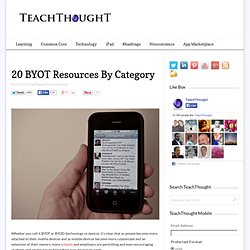
Devices may include laptops, tablets, smartphones and more. As a result, many educators are scrambling to get a handle on the issues surrounding the “bring your own device” trend. Resources abound on this topic, and some are offered below. General Overview, Best Practices.
Making a Case for Mobile Learning. Guest Post for SmartBlogs on Education Over the past four years, I have had the privilege of teaching in a forward-thinking school district that has embraced the use of mobile learning devices in the classroom.

Enhancing Information Language Learning with Mobile Technology - Does it Work? - 73% of Teachers Use Cellphones for Classroom Activities. More middle- and secondary-school teachers are using digital tools in their classrooms and professional lives, a new report says.

A study by Pew Research Center's Internet and American Life Project released Thursday delves into teachers' increasing technology use, but also expresses educators' concerns about the digital divide. The study surveyed Advance Placement and National Writing Project teachers across the United States, and 92% say the Internet has a "major impact" on their ability to access content, resources and materials for teaching.
Teachers are becoming advanced tech users, according to Kristen Purcell, Pew's associate director for research. "The findings bode well for people who really want to see these tools become a part of the educational sphere," Purcell tells Mashable. Use of mobile technology dominates the learning process, the study finds. Not only are educators using devices in the classroom, but they outpace typical online adults when it comes to personal tech use. Technology brings classroom experience to distance learners. Course materials can be downloaded on to mobile devices and accessed by students wherever they are.
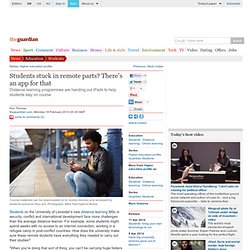
Photograph: Mike Harrington/Lifesize Students on the University of Leicester's new distance learning MSc in security, conflict and international development face more challenges than the average distance learner. For example, some students might spend weeks with no access to an internet connection, working in a refugee camp in post-conflict countries. How does the university make sure these remote students have everything they needed to carry out their studies? "When you're doing that sort of thing, you can't be carrying huge folders of printed material," says Prof Adrian Beck, head of the university's department of criminology.
The solution was to give every student on the course a free iPad, on to which they could download a bespoke app and all the course materials. A Roadmap For Successful Education App Development. 10 Ways To Become A Better Online Learner 8.34K Views 0 Likes There are some quick and easy ways to become a better online learner. Whether you're taking a class or just researching, here are the DOs and DON'Ts. Five reasons why QR and AR won’t take off on the London Underground.
This is Sartre.

This is me scratching an itch. Although there are plenty of statistics that suggest people have scanned QR codes out and about, used Blippar watching television and Aurasma whilst reading their sportsday match programmes, I’m a bit of a sceptic. Virgin’s provision of free WiFi on the London Underground, the service notably being free to use on Vodafone and EE, has led many to ponder how this will impact on marketing and advertising in the subterranean rat race. Some have claimed augmented reality (AR) will start to take off as the technology matures along with marketers, and there’s a signal to enable web content for QR codes/ RFID and the like. However, unless scanning is heavily incentivised, I’m of the opinion there are at least five reasons why this isn’t going to be heavily adopted, and you can agree or disagree in our comments section below. Mobiles are used by travellers to get rid of subjectivity. Excellent Resources on BYOD for Teachers. Mobile technology is making explosive growth into our schools and classrooms.There is now a growing trend towards taking advantage of mobile devices to inspire learning and promote students engagement, but the problem is that school districts can not cover the costs of these devices and to provide every student with a gadget would be out of their affordability particularly with the shrinking budgets being allocated for high tech materials.However, several initiatives have been taken to counter this financial block facing the implementation of mobile technology in classroom and one of these initiatives is called BYOD ( Bring Your Own Device).
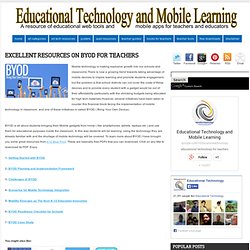
BYOD is all about students bringing their Mobile gadgets from home ( like smartphones, tablets. laptops etc ) and use them for educational purposes inside the classroom. English on Mobile. BYOT. From EdFutures Models of ICT provision | Desktop provision | Mobile loan | 1:1 | BYOD | BYOT Bring Your Own Technology (BYOT) refers to learners being able to bring any mobile computing device in to school and connect it to the school network, without having to register the device in advance.
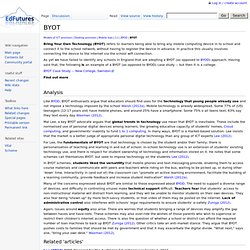
In practice this usually involves connecting the device to the internet via the school wifi connection. As yet we have failed to identify any schools in England that are adopting a BYOT (as opposed to BYOD) approach. Having said that, the following is an example of a BYOT (as opposed to BYOD) case study -- but then it is a college: BYOT Case Study -- New College, Swindon. BYOD. From EdFutures Models of ICT provision | Desktop provision | Mobile loan | 1:1 | BYOD | BYOT Bring Your Own Device (BYOD) refers learners being able bring any mobile computing device in to school and connect it to the school network, so long as they have registered the device in advance with the school.
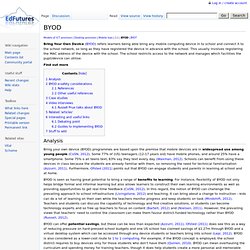
This usually involves registering the MAC address of the device with the school. The school restricts access to the network and manages which facilities the pupil/device can utilise. Articles - Educational Technology.
Mlearning research. Smart Phones and Language Learning. Semaine de l’apprentissage nomade de l’UNESCO 2013. L’UNESCO lance la deuxième Semaine de l’apprentissage nomade (MLW). Elle se déroulera au Siège de l’Organisation, à Paris, du 18 au 22 février 2013. Reforming Foreign Language Studies in Serbia - Calendar - E-learning symposium 2013. January 2012. Mobile Learning and the Future of Learning: An HETL Interview with Dr. Agnes Kukulska-Hulme. February 28, 2012 in Volume 2 HETL Note: Dr. Agnes Kukulska-Hulme has written and edited several books on mobile learning, among them, Mobile learning: A handbook for educators and trainers, Routledge, 2005 (co-edited with John Traxler), and Researching mobile learning: frameworks, tools and research designs, Peter Lang, 2009 (co-edited with Giasemi Vavoula and Norbert Pachler).
In her personal statement on the Open University Web site Dr. Kukulska-Hulme explains that she is interested in a broad spectrum of topics related to the use of mobile technologies, including learner and teacher perspectives on mobile learning, impact on second language teaching and learning, sharing and dissemination of good practice, and connecting policy and practice. HETL interviewed Dr. Bio: Dr.
Understanding Mobile Users - Google Think Insights. Mobile Devices for Enhancing Memory Encoding and Recall. John Medina reveals in his book Brain Rules: 12 Principles for Surviving and Thriving at Work, Home, and School that the initial stage of learning – the encoding stage – is the most critical step in the acquisition of knowledge attainment. He then proceeds to discuss three primary encoding processes: Mlearning. Nextstepv2. What Does a Good Mobile Learning Strategy Look Like? Last week we established a few baseline expectations of the benefits of a mobile learning strategy.
We talked about how it affects your immediate team, your external stakeholders and how it improves the long-term success of your mobile learning efforts. With those points in mind, you’re probably ready to get your efforts underway in creating a strategy. Hold on there, partner. Smart phones driving lecture capture growth. Dokkiri Hand Case for iPhone 4 (Kid's Hand)
Portables dans les écoles: une pub téléphonée pour Chatel. Il y a des saillies gouvernementales qui ne débouchent sur rien. Et puis il y a les sorties d’un ministre qui tombent à pic, par exemple la veille du vote d’une loi qui semble sortie de nulle part. Au grand bénéfice du ministre en question, que l’on crédite d’un pouvoir de conviction incroyable sur les parlementaires et d’un grand sens de l’a propos. Ce qui vient de se produire avec l’interdiction des portables à l’école. Mardi 6 octobre, RTL décide d’en faire son grand dossier du matin. Pourquoi ce jour-là ?
Ça tombe bien : ce mardi-là, c’est Luc Chatel, porte-parole du gouvernement et ministre de l’Education, qui est l’invité du matin sur les ondes de RTL. GLMPS iPhone App Brings Motion to Photo Sharing. 100 Mobile Tools for Teachers. By Cherrye Moore It is a common-known fact that teaching is a labor of love for most educators.